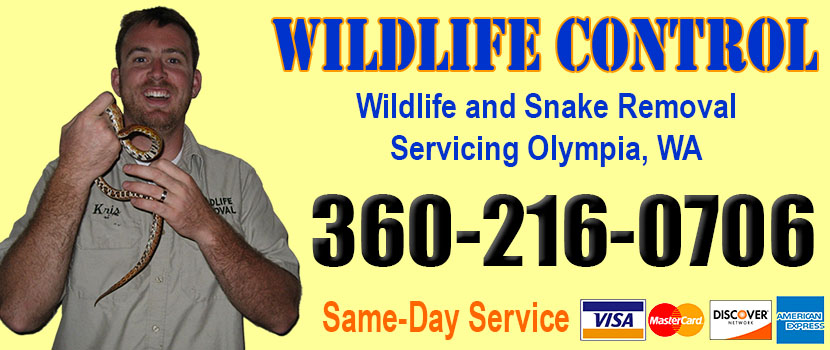
Welcome to olympiasnakes.com! I am David, a snake enthusiast living in Olympia, WA. Many people don't know that Olympia is in fact full of snakes! You just need to know where to find them - they can often be shy and elusive. Some Washington snake species are more common outside of the city limits, in different parts of Thurston County WA, but many types of snakes are indeed common in the more urban parts of Olympia. This guide is meant to help educate you about the beautiful snakes of Olympia, and to help you identify the most common snakes of Olympia, as well as the venomous snakes of Olympia that you should learn to recognize and avoid. If you want more detail, click here for my complete list of ALL snake species in Olympia. Remember the following:
- Most snakes of Olympia are harmless and don't want to encounter you
- Venomous snakes exist but are uncommon in Olympia, Washington
- Snakes eat rats and mice and are a valuable part of the Washington ecosystem
- Never kill a snake - if you leave a snake alone, it will leave you alone.
Common Snake Species in Olympia
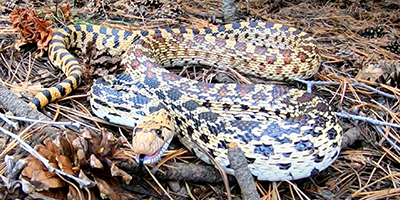 Gopher Snake:
Also known as the bull snake, these snakes are robust and are commonly found in warm, dry places. An adult gopher snake can be as long as 3 to 4 feet in the wild. The dark blotches along the tan on its back make it quite easy to identify them. If you find a gopher snake around your home, you don't have to harm them, as these snakes are non-venomous and are of no threat to you in any way.
Due to its body patterns and colorations and its ability to impressively display loud hissing sounds, strike aggressively, and coil, they are usually mistaken for venomous rattlesnakes. Gopher snakes are majorly constrictors; they take down their prey by squeezing them until they suffocate.
Gopher Snake:
Also known as the bull snake, these snakes are robust and are commonly found in warm, dry places. An adult gopher snake can be as long as 3 to 4 feet in the wild. The dark blotches along the tan on its back make it quite easy to identify them. If you find a gopher snake around your home, you don't have to harm them, as these snakes are non-venomous and are of no threat to you in any way.
Due to its body patterns and colorations and its ability to impressively display loud hissing sounds, strike aggressively, and coil, they are usually mistaken for venomous rattlesnakes. Gopher snakes are majorly constrictors; they take down their prey by squeezing them until they suffocate.
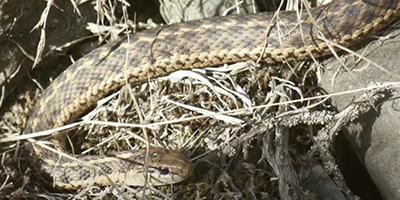 Western Terrestrial Garter Snake:
Here is another snake you are most likely going to find roaming around water areas in Olympia Washington. Western terrestrial garter snakes are either black or gray-brown with checked patterns with dark and yellow stripes. This unique coloration makes it an easy snake to identify in Olympia Washington. These snakes are average in size and can grow to a length of 40 inches. Western terrestrial garter snakes are non-venomous, so you don't have to freak out when you come across it.
Western Terrestrial Garter Snake:
Here is another snake you are most likely going to find roaming around water areas in Olympia Washington. Western terrestrial garter snakes are either black or gray-brown with checked patterns with dark and yellow stripes. This unique coloration makes it an easy snake to identify in Olympia Washington. These snakes are average in size and can grow to a length of 40 inches. Western terrestrial garter snakes are non-venomous, so you don't have to freak out when you come across it.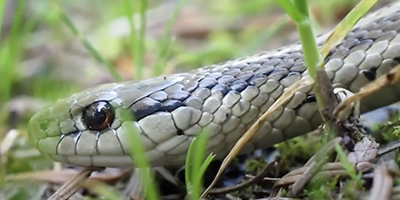 Common Garter Snake:
In Olympia Washington, the probability of you coming across this non-venomous snake is very high. They are more common in wet gardens or areas where there are shallow waters. These common garter snakes have a colorful coloration that enables anyone to easily identify them. They have bright colored stripes which is usually a mix of green, blue, and yellow that runs through the upper surface of their body. While their underside usually has a grayish-blue color. A mature common garter snake can grow as long as 2 to 3 feet.
Common Garter Snake:
In Olympia Washington, the probability of you coming across this non-venomous snake is very high. They are more common in wet gardens or areas where there are shallow waters. These common garter snakes have a colorful coloration that enables anyone to easily identify them. They have bright colored stripes which is usually a mix of green, blue, and yellow that runs through the upper surface of their body. While their underside usually has a grayish-blue color. A mature common garter snake can grow as long as 2 to 3 feet.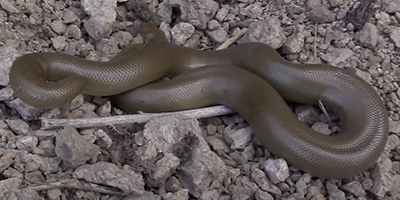 Rubber Boa:
Although it has no venom capable of harming humans, this snake is one to be feared in Olympia Washington. This local species measures about 14 to 30 inches when fully matured and it is one snake your pets shouldn't come across in this city. The rubber boa is either reddish-brown, chocolate-brown, tan, or olive green in color, depending on the color of its environment.
Just as its name implies, the rubber boa has a rubber-like appearance and it has a blunt, short, and broad snout. The shape of this mouthpart gives it a two-headed appearance and also allows it to swallow large prey with ease.
Rubber Boa:
Although it has no venom capable of harming humans, this snake is one to be feared in Olympia Washington. This local species measures about 14 to 30 inches when fully matured and it is one snake your pets shouldn't come across in this city. The rubber boa is either reddish-brown, chocolate-brown, tan, or olive green in color, depending on the color of its environment.
Just as its name implies, the rubber boa has a rubber-like appearance and it has a blunt, short, and broad snout. The shape of this mouthpart gives it a two-headed appearance and also allows it to swallow large prey with ease.
Venomous Snake Species in Olympia
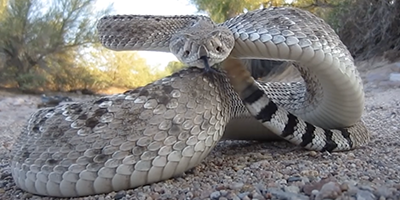 Western Rattlesnake:
Despite being a venomous snake, this particular species of rattlesnake is very docile and won't strike unless threatened. They are distinguished by their triangular and broad head which is usually much wider than their neck. Another distinguishing feature that can be used to identify the western rattlesnake is their body pattern. This snake has a diamond-shaped pattern along the middle side of its back and it also possess a rattle that has a black and white crossbar at the tip of its tail.
The western rattlesnake can grow up to 4 feet at maturity and the venom from it can shut down the nervous system of a human's body within minutes. And depending on the habitat it inhabits, the skin color ranges from gray to olive to brown
Western Rattlesnake:
Despite being a venomous snake, this particular species of rattlesnake is very docile and won't strike unless threatened. They are distinguished by their triangular and broad head which is usually much wider than their neck. Another distinguishing feature that can be used to identify the western rattlesnake is their body pattern. This snake has a diamond-shaped pattern along the middle side of its back and it also possess a rattle that has a black and white crossbar at the tip of its tail.
The western rattlesnake can grow up to 4 feet at maturity and the venom from it can shut down the nervous system of a human's body within minutes. And depending on the habitat it inhabits, the skin color ranges from gray to olive to brown
If you're unsure, you can email me a photo of the snake at info@olympiasnakes.com and I will email you back with the snake's species. If you found a snake skin, read my Found a Skin? page, and you can email me a photo of the skin, and I'll identify the snake for you. If you need professional Olympia snake removal help, click my Get Help page, or see the below website sponsor I found, who provides that service.
Will Snakes Take Care of Their Offspring?
Most birds and mammals are known for taking care of their young ones; however, most reptiles will immediately abandon their kids after giving birth to them. Even the snakes that will lay eggs will leave the incubation process on the heat of the environment. However, there are still species of snakes that are proactive in taking care of their babies. They will feed them and provide them with protection until they can survive on their own.
Will Vipers Care for Their Young?
Vipers are probably the most well-known reptile species that are capable of exhibiting parental care. This is quite ironic since they are famous for being fierce and for their deadly venom. While this behavior has been found apparent on vipers as early as the 1850s, it was only until the 1990s when the scientific community accepted it. Initially, they believed that the animal was too vile to show caring behavior. Today, there are loads of articles that talk about the vipers' caring nature, such as the rattlesnakes, to their babies. They will be guarding their young ones until their first molting. The first shedding is an indication for them to leave the babies. Since the vipers are known for swallowing their prey whole, it would be impossible for them to feed their babies.
Will the Pythons Show Parental Care?
Another perfect example of a snake capable of showing care to their kids would be the python. All 40 species of pythons will coil their body around the eggs to incubate them. During this period, they will be disregarding their nourishment. For the pythons that live in the cooler area, their muscles will contract to produce even more heat for the eggs. They will even brood rocks with the same size as their eggs and the eggs of another python mother. Once they hatched, the mother will have interaction with the babies for two weeks.
Do King Cobras Feed Their Young?
King Cobras, one of the most feared creatures in the wild, are known for their unique ways of building a nest for their eggs. They are very detailed when looking for the possible location of their nest. They have one of the largest and the most complex nests among the different species of snakes. It features an internal chamber where the 20-50 eggs of the king cobra can be found. Unfortunately, they will also not feed their young since they will abandon the nest right before the eggs hatch. There have been some observations that the animal will be more aggressive when they are protecting their nest.
Except for the family of pit vipers, the maternal care of these slithering creatures still baffles the experts and has yet to be thoroughly examined. They are probably doing this to deter any possible predators from attacking the eggs. Furthermore, their habit of devouring the prey makes it difficult for them to feed the baby snakes. According to the experts, the mother reptile is aware that the eggs will have a higher survival rate if she leaves the nest.
Remember, the term is not poisonous snakes of Olympia, it's venomous snakes of Olympia. Poison is generally something you eat, and venom is injected into you. That said, dangerous snakes are very rare in Olympia. The few venomous snakes of Thurston County are rarely seen. But they are commonly misidentified, so learn about all the snake species of Olympia in order to correctly identify them. These snakes are usually also found in the surrounding towns of Olympia, Lacey, Tumwater, Yelm, Nisqually Indian Community, Rochester, Tenino, Rainier, Grand Mound, Bucoda, Tanglewilde, North Yelm, and the surrounding areas.
Read our article about:
The Snakes Eating Behavior
olympiasnakes.com domain and hosting costs made possible by the generous support of this sponsor:
